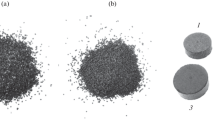Abstract
The kinetics and isotherm of lysozyme adsorption and the strength of lysozyme binding to two carbon materials, activated charcoal and carbon foil, were studied using tritium-labeled lysozyme. Polyethylene films were used as a model nonporous material. The lysozyme adsorption resulted in modification of the surface of the materials, making it more hydrophilic, and the rate at which the adsorption equilibrium was attained depended on the capability of the lysozyme solution to penetrate into pores of carbon materials. The specific coverage of the surface of graphite foil, activated carbon, and polyethylene with lysozyme appeared to be virtually equal when taking into account only pores accessible to the protein. The lysozyme adsorption on the polyethylene surface is reversible, whereas on the surface of activated charcoal and graphite foil it is practically irreversible. The possibility of modification of the carbon foil surface with a lysozyme solution to increase the adsorption zone was confirmed by autoradiography.
Similar content being viewed by others
References
Smith, S.C., Ahmed, F., Gutierrez, K.M., and Rodrigues, D.F., Chem. Eng. J., 2014, vol. 240, pp. 147–154.
Zeinabad, H.A., Zarrabian, A., Saboury, A.A., et al., Sci. Rep., 2016, vol. 6, article no. 26508.
Ding, Y., Tian, R., Yang, Z., et al., Biophys. Chem., 2016, vol. 218, pp. 36–41.
Georgakilas, V., Perman, J.A., Tucek, J., et al., Chem. Rev., 2015, vol. 115, pp. 4744–4822.
Gruner, G., Anal. Bioanal. Chem., 2006, vol. 384, pp. 322–335.
Okpalugo, T.I.T., Ogwu, A.A., Maguire, P.D., et al., Diam. Relat. Mater., 2004, vol. 13, pp. 1088–1092.
Bolisetty, S. and Mezzenga, R., Nat. Nanotechnol., 2016, vol. 11, pp. 365–371.
Lousinian, S., Kalfagiannis, N., and Logothetidis, S., Mater. Sci. Eng. B, 2008, vol. 152, pp. 12–15.
Huang, Y., Lü, X., Jingwu, M., and Huang, N., Appl. Surf. Sci., 2008, vol. 255, no. 2, pp. 257–259.
Pamula, E. and Rouxhet, P.G., Carbon, 2005, vol. 43, pp. 1432–1438.
Tansel, B. and Dizge, N., J. Environ. Manag., 2011, vol. 92, pp. 596–602.
Lei, Z., Cao, Y., Dang, L., et al., J. Colloid Interface Sci., 2009, vol. 339, pp. 439–445.
Hippauf, F., Lunow, D., Huettner, C., et al., Carbon, 2015, vol. 87, pp. 309–316.
Bonilla, T.S. and Allen, D.G., Can. J. Chem. Eng., 2016, vol. 94, pp. 231–237.
Yushin, G., Hoffman, E.N., Barsoum, M.W., et al., Biomaterials, 2006, vol. 27, pp. 5755–5762.
Zolotare., Yu.A., Dadayan, A.K., Bocharov, E.V., et al., Amino Acids, 2003, vol. 24, pp. 325–333.
Zolotare., Yu.A., Dadayan, A.K., Kozik, V.S., et al., Russ. J. Bioorg. Chem., 2014, vol. 40, no. 1, pp. 26–35.
Chernysheva, M.G. and Badun, G.A., J. Radioanal. Nucl. Chem., 2010, vol. 286, pp. 835–840.
Badun, G.A., Chernysheva, M.G., and Ksenofontov, A.L., Radiochim. Acta, 2012, vol. 100, pp. 401–408.
Chernysheva, M.G. and Badun, G.A., Langmuir, 2011, vol. 27, pp. 2188–2184.
Razzhivina, I.A., Badun, G.A., Chernysheva, M.G., et al., Radiochemistry, 2017, vol. 59, no. 3, pp. 284–291.
Hildebrand, N., Köppen, S., Derr, L., et al., J. Phys. Chem. C, 2015, vol. 119, pp. 7295–7307.
Mitropoulos, V., Mütze, A., and Fischer, P., Adv. Colloid Interface Sci., 2014, vol. 206, pp. 195–206.
Chukhrai, E.S., Pilipenko, O.S., Ovsyannikov, R.A., et al., Russ. J. Phys. Chem. A, 2010, vol. 84, no. 11, pp. 1986–1992.
Pilipenko, O.S., Atyaksheva, L.F., Kryuchkova, E.V., and Chukhrai, E.S., Russ. J. Phys. Chem. A, 2012, vol. 86, no. 8, pp. 1301–1307.
Kelly, J.A., Sielecki, A.R., Sykes, B.D., et al., Nature, 1979, vol. 282, pp. 875–878.
Author information
Authors and Affiliations
Corresponding author
Additional information
Original Russian Text © G.A. Badun, M.G. Chernysheva, I.A. Razzhivina, 2017, published in Radiokhimiya, 2017, Vol. 59, No. 3, pp. 255–259.
Rights and permissions
About this article
Cite this article
Badun, G.A., Chernysheva, M.G. & Razzhivina, I.A. Use of tritium-labeled lysozyme for studying its adsorption on porous carbon materials. Radiochemistry 59, 292–296 (2017). https://doi.org/10.1134/S1066362217030122
Received:
Published:
Issue Date:
DOI: https://doi.org/10.1134/S1066362217030122




